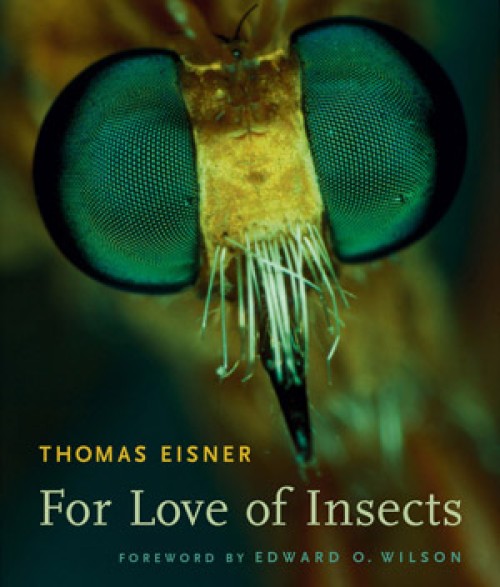by By Thomas Eisner
The Belknap Press of Harvard University Press, 2003
Each of the 10 chapters in this book begins at a beginning, with the author discovering a new insect or other arthropod or a behavioral quirk of a previously known one. Then we are off, following Eisner, a renowned entomologist, usually accompanied by a graduate student or colleague, as he observes, collects, analyzes, and photographs the subject at hand. The creatures are brought into the lab – sometimes a makeshift lab in a motel room if he is traveling – and he describes in detail the methods that are used to figure out just what the creature is doing and how it is doing it.
The range of his investigations is wide, from using an electron microscope to examine the tarsal bristles of a beetle that clings to a palmetto leaf to considering broad ecological themes, noting often the evolution of new defensive strategies in insects to counter the ever-more-elaborate offenses of their predators.
Clearly, he admires the animals he studies. When he tries to pull 13.5-milligram, tarsal-bristled beetles from the leaves of their palmetto host, using a glue made of dental wax, a thin wire, a pulley, and a weight, the beetles hunker down and cling tenaciously, averaging 2 grams of adhesive strength. Eisner is obviously impressed: “Two grams amounts to 148 times their body mass. Think of it. In human equivalents – relative to a 155-pound human – this amounts to about 23,000 pounds, or 7.5 automobiles (Subaru Legacy station wagons, 1998 model).” And after the champion beetle clung with a mighty 240 times its body mass: “We celebrated that performance with a glass of wine.”
There are photographs of everything: the animal, its habitat, the lab equipment, and scanning electron microscope images of whatever bristles, hairs, or glands are being studied. Cameras seem to have recorded the progress of each investigation, every step of the way, and the images are both illuminating and beautiful. Charts and diagrams help out, too.
The book is set up to make life a breeze for its readers, which, for some of us, is essential as the subject matter is predominantly the chemicals that small animals use to defend themselves against predators. Instead of being intimidated, we are lured into believing that we might even be co-discoverers of such things as the ways that fireflies acquire defensive toxins called lucibufagins, or how beetles are physiologically equipped to aim a hot spray of benzoquinones directly at an attacker. The ubiquitous ant is frequently the enemy that other insects are seeking to chemically or behaviorally thwart, but Eisner also explores in detail the reasons that fish don’t eat whirligig beetles or why moths and green lacewings keep from getting caught in spider webs.
I didn’t like the title of this book, and consequently it stayed in our house unopened for several months. I’m glad I overcame my aversion, and though I still don’t like the title, there’s no doubt that Thomas Eisner does, indeed, love insects, and some of that is sure to rub off on anyone who reads his book.


